CellTrack is a neat little application for Series 60 mobile phones, like my Nokia N70, that displays information about the current “cell” in the network that the phone is connected to. Here’s a screen shot:
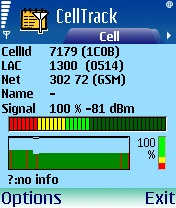
But what does all that stuff mean?
The first item, CellId, is “the id from the actual cell” says the CellTrack documentation. Add that to information from this useful page:
The last digit of the Cell ID is actually the sector number, and it will be 7, 8, or 9 on any 1900 MHz channel, and 1, 2, or 3 on any 850 MHz channel. The remaining digits are the CID shown in the list below. That means that if you see 22148 on your phone, the CID is 2214, and you are picking up sector 8 (which is a 1900 MHz channel). 22142 would be the same sector, but on an 850 MHz channel. Rogers are very methodical about their sector designations. Sectors 2 and 8 are the ones that face south, while sectors 1 and 7 face northeast, and sectors 3 and 9 face northwest.
Moving around town I see that the CellId varies through 7177, 7178 and 7179; this suggests that the “Cell ID” is 717, that it’s communicating on 1900 MHz, and that my phone is variously communicating with the south, northeast and northwest “sectors” of the cell. So I’m presuming this means that I’m talking to various bits of the same cell tower. Note that the 1C0B is just 7179 in hex.
The LAC of 1300 is said to be the “Location Area Code from your cell.” Obviously this isn’t my “area code” in the classic telephone sense (902); apparently it identifies “which general area you are in.” This is further explained in this document, which offers the definition (“PLMN” means “Public Land Mobile Network” or, in other words, “mobile phone company”):
a set of cells of a PLMN grouped together may for[m] a LA. A LA is identified by a LAC. A LA the smallest area where a MS can be paged. A LA is also the smallest area, which can be barred for roaming
The Net of 302 72 is a two-part code that, it says here is the “network code” for Rogers Wireless. The 302 is the “Mobile Country Code” for Canada; the 72 is the “Mobile Network Code” for Rogers.
I presume that those with access to Rogers cell databases can use this information to pinpoint my location somewhat. There are grassroots efforts to tie cell IDs to locations: here’s one for Australia, and this one and this one for Canada. And of course there’s the upcoming Plazes feature that uses the same data.
I welcome additional fleshing out of the information above by those who Know More.
One of the roles of the Island Regulatory and Appeals Commission (IRAC) is to oversee the administrative aspects of amendment and cancellation applications under the Lands Protection Act. In short, this means that they handle the paperwork when land owners wish to have their land “de-identified” for non-development; this is traditionally undertaken when owners of “identified” agricultural land want to subdivide it, or use it for commercial or industrial purposes.
Once IRAC’s administrative role is complete, the applications go to the Department of Community Services for decision by the Minister and an Executive Council Order is made pursuant to that decision.
IRAC has helpful page on its website that allows a search of processed applications. If you’re interested in following the activity in this area, however, you need to regularly visit the website to check for new applications. This is an area where RSS could be quite handy, so I’ve created an experimental RSS feed of processed applications.
The RSS feed is generated by scraping the data from the IRAC website, dumping it into a database, sorting in reverse chronological order of decision date, and then spitting out the most recent 25 processed applications. Here’s what it looks like in NetNewsWire:
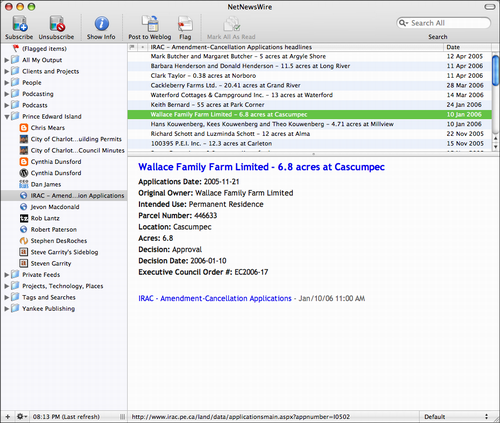
In theory, thus, every time a new application is processed and added to IRAC’s database, the RSS feed should show it as the latest item.
IRAC offers permissions for use of its information in this manner, with the following proviso:
Information on this Web Site is made available by the Commission for the purpose of public information and research. The Commission hereby grants permission to use the information provided it is accurately reproduced and an acknowledgement of the source is given. The information may not be sold or offered for sale without the express written authorization of the Commission.
Note that, at present, the RSS feed doesn’t include “Corporate and Non-Resident Applications.”
Regular readers will recall my tales of our yearly trips to the New Years Day Levees in Charlottetown. This year I got my photo with Premier Pat Binns mailed to me 7 months earlier than last year; I can only assume I’m moving up the provincial hierarchy. Here’s a gallery:
2004
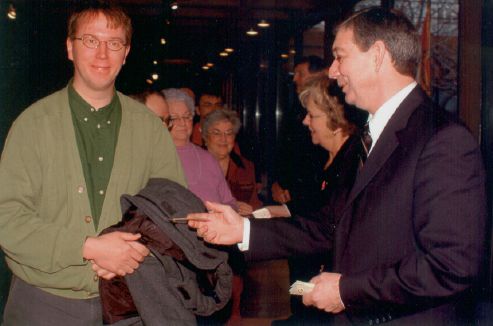
2005
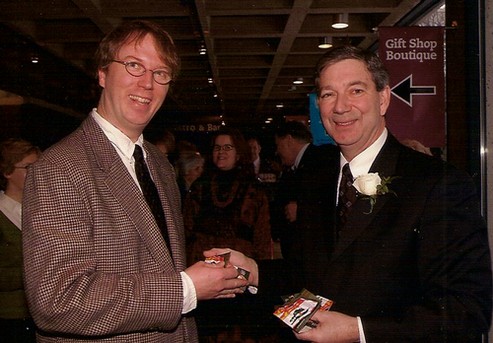
2006

It seems that at least four of Prince Edward Island’s radio stations are streaming their programs to the Internet:
Just before 9:00 a.m. this morning the power went out on Prince Edward Island from West Royalty all the way to East Point. The Maritime Electric trouble line reports that they haven’t located the source of the problem yet. Meanwhile things are humming along upstairs in the Data Centre, courtesy of generators at silverorange and ISN.
Here’s an inside look at Data Centre in “emergency operations mode.” Note the coffee maker.
And here’s a shot of Nathan’s laptop, running off the generator, showing live video of an eagle in British Columbia streaming. I think he was just showing off ;-)
The Brackley Drive-in Theatre is opening early this year: starting May 5 the theatre will be open weekends (daily shows start later in the season). The first double feature: Mission Impossible 3 and Failure to Launch.
The Gros Morne Project, a production of my friends at Coleman Lemieux & Compagnie, now has its own website.
One of the items that came up in our big Montreal summit meeting at Coleman Lemieux & Compagnie was that they need a better way of handling their telephone life. Right now they’ve got one incoming telephone line that they use for home and business, and so end up with a confusing mix of personal and business calls. To say nothing of the challenges of handling calls when they’re in Russia.
Having a handy Asterisk-based telephone system here in Charlottetown, I was able to jump to the rescue: I bought a $3.50/month Montreal number from GloboTech (easy to do, excellent service and documentation), routed it through my Asterisk system and created a custom set of voicemail prompts.
So now callers can phone a local Montreal number, get prompted for Laurence, Bill or Cyrille, and their call can get routed to the appropriate land line, cell phone or email box depending on who is where.
Total time from dream to implmentation: 45 minutes. Cool.
Okay, so I’ve managed, through the process of trial and error, to figure out how much Rogers Wireless charges for data access with a “Pay As You Go” account.
There is an air of confusion over the entire issue because their rates page says only that they charge 2 cents per page for “Surfing on your mobile Internet browser.” They don’t list any rates for data that isn’t “surfing” and therefor doesn’t involve “pages.”
To deduce what they do charge, then, I did a test with my Nokia N70, which has a byte counter (look under Log \| Packet Data) and an IMAP client. I reset the counters, checked my account balance on the Rogers website, checked my email, noted the total of the “data sent” and “data received” counters, and then checked my account balance again.
Total data transferred during the IMAP mail check was 9.92kb, or 10158 bytes. Total charge was 50 cents. So it looks like the data charge is 5 cents per kilobyte.
This is tantamount to “so expensive as to be completely useless.” To give you an idea of how expensive: uploading this photo would have cost me $6.60 and downloading today’s episode of the Daily Source Code would cost $2856.
It turns out that, buried deep within their website Rogers does, indeed, reveal this rate:
Data usage with data devices or integrated phone and data devices on Pay As You Go service will be charged at 5 cents / kb. A minimum account balance of $5.00 is required to access the navigate mobile Internet. Balance is held for the duration of the navigate session and credited back to the Pay As You Go account at the end of the browsing session.
Things get somewhat cheaper if you’re not a “Pay As You Go” customer — Rogers’ consumer plans include one that provide 1MB of data transfer for $7/month, or 0.7 cents per kilobyte, with a 2 cents/kb rate over the 1MB amount. That would lower my Daily Source Code download to the $1000 range.
Obviously Rogers is positioning wireless data as a tool for millionaires and insane people.
Unable to handle the constant chiding about the fuzzy little photos coming out of my T610, I’ve upgraded to a Nokia N70. Here’s the first photo:
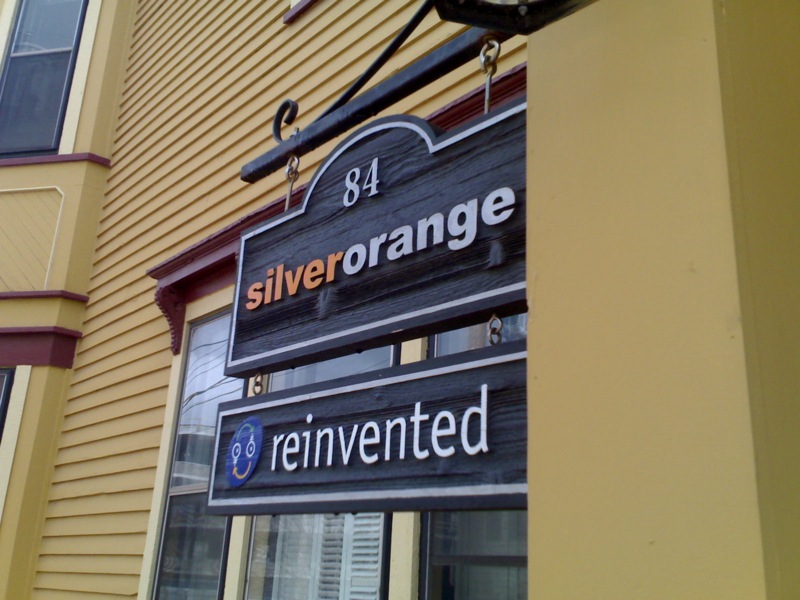
 I am
I am